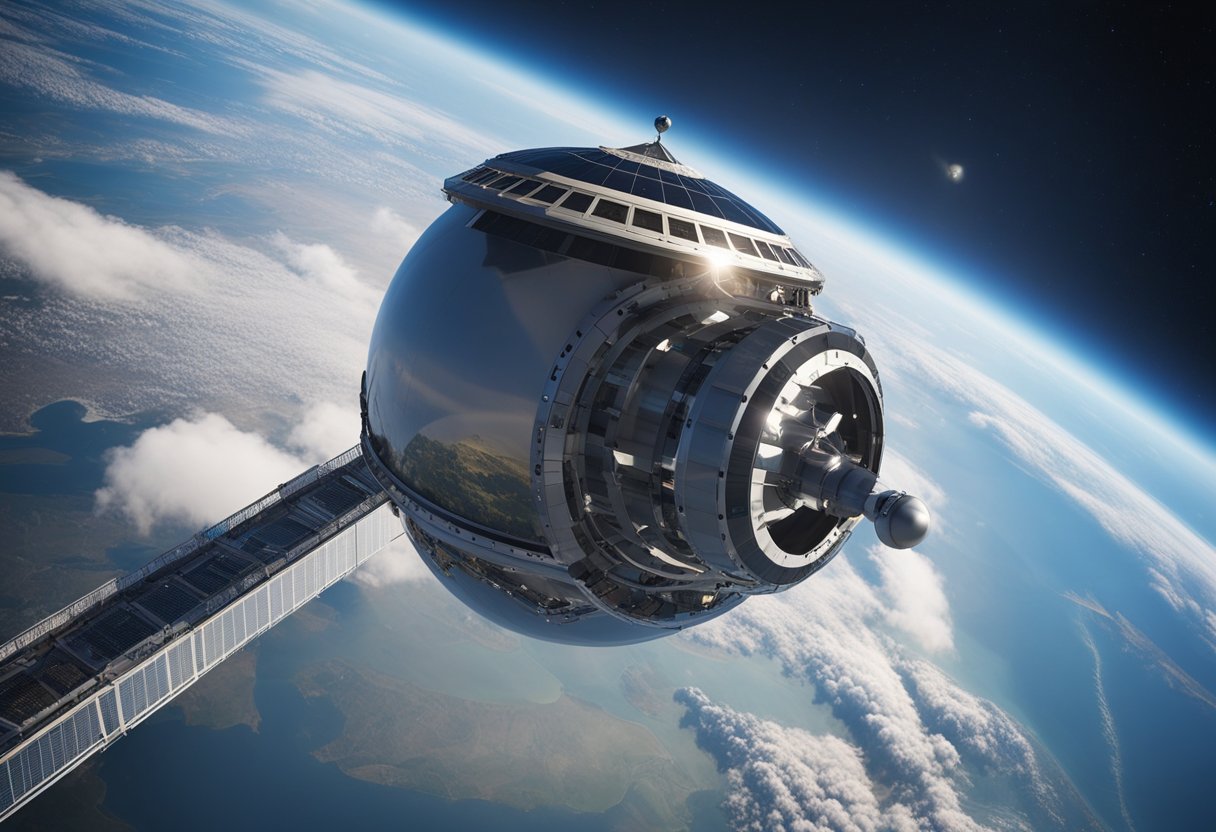
Space Elevator Concepts – A space elevator represents an ambitious leap in space transportation technology, envisaged as a structured means of sending payloads directly into space without the need for rocket propulsion. The core idea involves a cable, also known as a tether, anchored to the Earth’s surface, extending into space to a counterweight stationed in a higher orbit. This engineering marvel has the potential to revolutionise access to space, offering a more cost-effective and sustainable alternative to the traditional methods of launching spacecraft via rockets.
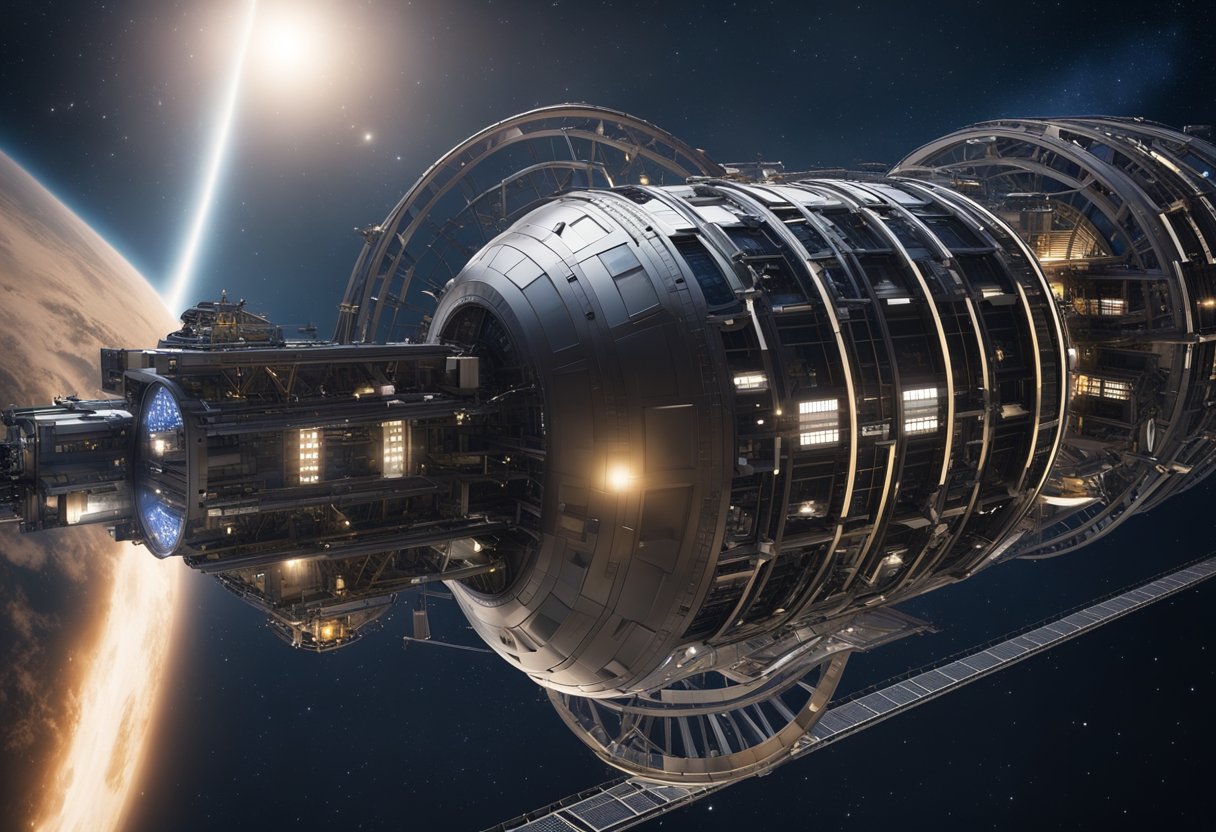
The concept has evolved over the years, gaining a footing in both science and engineering discussions, primarily due to the potential benefits it could deliver across various aspects of space exploration and infrastructure. It intertwines complex disciplines such as orbital mechanics and materials science, posing significant engineering challenges concerning the creation of a cable both strong and light enough to withstand the forces exerted upon it. Moreover, in designing such a system, consideration must be given to safety measures for dealing with space debris and ensuring the safe transportation of spacecraft and payloads.
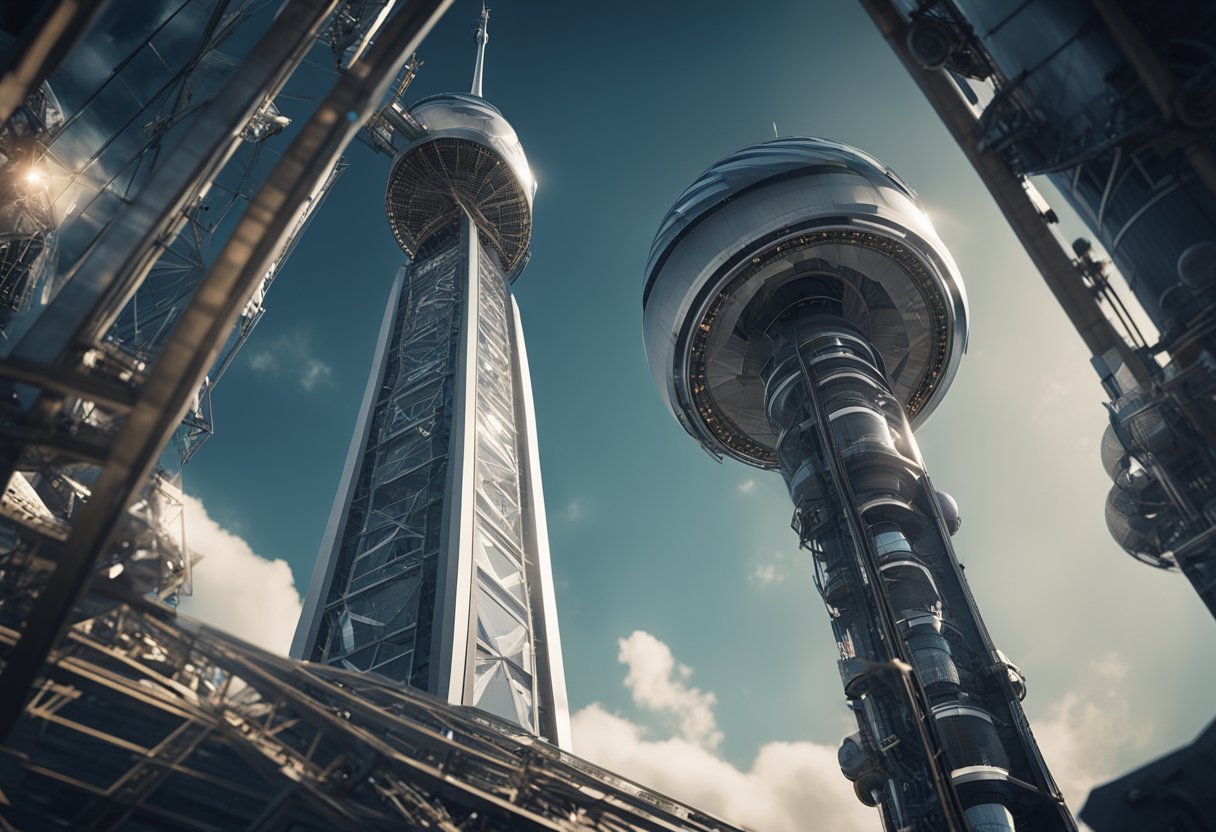
In exploring the concept of the space elevator, we uncover a tapestry of innovative ideas and pioneering individuals whose contributions have been pivotal in refining this revolutionary mode of space access.
The seed of the space elevator concept was sown by the imagination of Konstantin Tsiolkovsky following his contemplation of the Eiffel Tower. He envisaged a ‘celestial castle’ at the end of a spindle-shaped cable with the opposing force of Earth’s rotation creating the necessary tension to keep it taut. This marked the genesis of a vision for a tower reaching into the heavens, first proposed in 1895. Tsiolkovsky’s notion laid the groundwork for all future conceptual developments related to space elevators.
Teaching Students About the Space Elevator Concept elaborates on how this initial idea can be a valuable tool for educational purposes, grounding the concept not only in science but also in its historical progress.
As the twentieth century progressed, leaps in technology and science fiction kept the concept of the space elevator alive. Jerome Pearson reintroduced it in a modern context, with the innovative suggestion of a centrifugally taut cable extending into space. His work in the 1970s garnered the attention of the scientific community, resuscitating the discussion surrounding space elevators.
Arthur C. Clarke, not merely content to speculate on this theme, bolstered it with his writing, most notably in his novel “Fountains of Paradise”. Clarke’s influence spanned beyond literature, cementing the idea within the public consciousness and scientific discourse alike.
Furthermore, Yuri Artsutanov, a Russian engineer, independently arrived at a similar concept to Pearson, advocating for a geosynchronous orbital station connected to the ground by a thin, strong cable. His ideas were disseminated through an influential article published in “Komsomolskaya Pravda”, igniting interest across the Soviet Union.
The British Interplanetary Society has also played a role by providing a serious platform for discussions and studies, fostering an environment where such revolutionary concepts could be earnestly analysed and debated.
In our contemporary era, as we stand on the fringes of space tourism with emerging ventures like SpaceVoyageVentures.com outlining the burgeoning industry, these historical contributions remind us that today’s science fiction is often tomorrow’s science fact.
As we examine the concept of space elevators, we’re delving into a revolutionary approach to space access that promises to bypass many limitations of traditional rocket launches. Our focus here is on the essential mechanics that enable this technology and the intricacies of the tether, which is at the heart of the design.
The basic principle behind a space elevator rests on creating a stable, stationary mechanical connection between the Earth’s surface and space. The cable, also known as the tether, plays a critical role in this system. It’s designed to be anchored to the Earth’s surface, stretching to geostationary orbit, where it must maintain a fixed position above a single point on the equator. Achieving this requires a tensile strength that can withstand the forces involved in extending and maintaining a cable across such a vast distance.
The design of the tether is arguably the most challenging aspect of the space elevator, with carbon nanotubes being the prime candidate for material due to their exceptional strength-to-weight ratio. The tensile strength of carbon nanotubes potentially exceeds that of any other known material, which is why they’re being considered for the tether despite the current challenges in manufacturing them at the necessary scale and purity.
By focusing on these technical aspects, we’re paving our path towards a future where space travel could become more routine and economically viable thanks to developments like those explored at SpaceVoyageVentures.com, providing a glimpse into a not-so-distant future of space exploration and tourism.
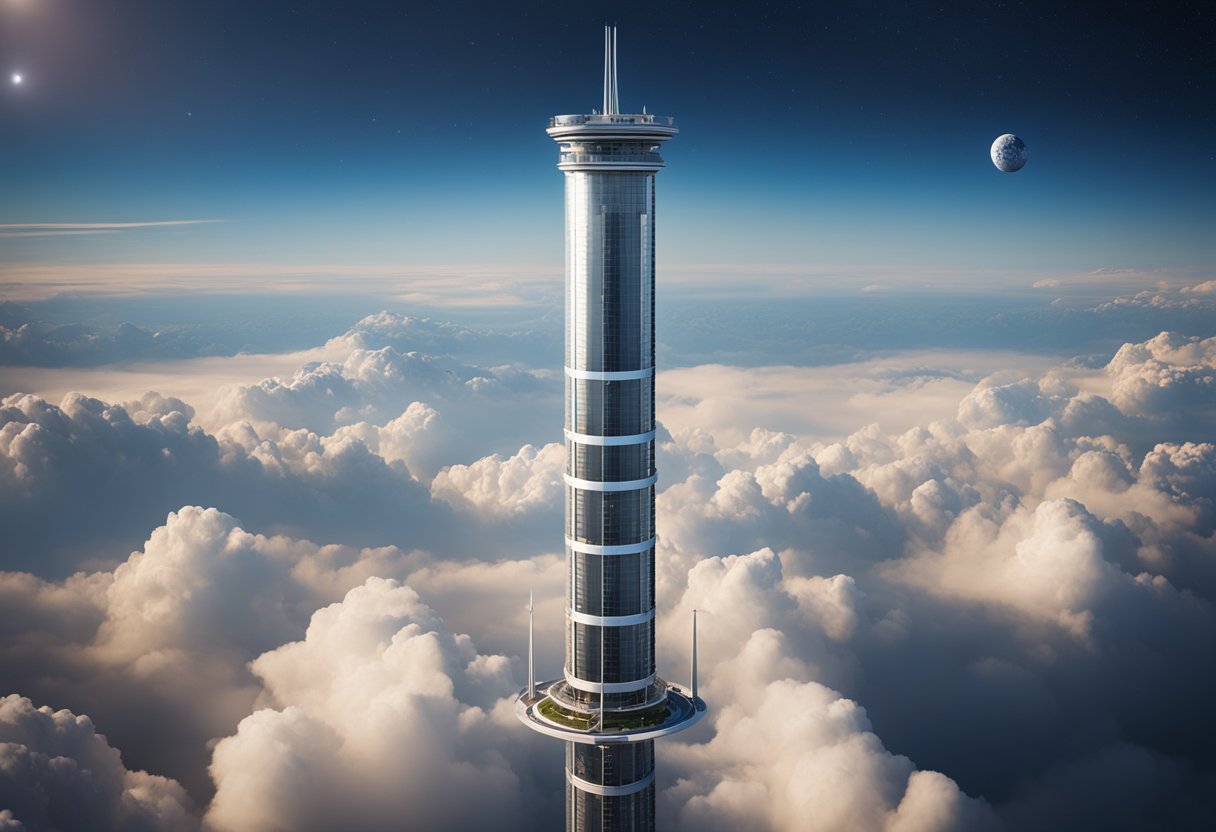
In our consideration of space elevator construction, the paramount issue is the choice of materials. Their strength-to-weight ratio and durability define the feasibility of such a colossal project.
Carbon nanotubes stand at the forefront of our material considerations due to their exceptional tensile strength and elasticity. These nanotubes are cylindrical molecules consisting of rolled-up sheets of single-layer carbon atoms (graphene). Their strength surpasses that of steel, while their weight is significantly lower. Advancements in nanotubes have led to prototypes that suggest a promising future for space elevator cables.
Ongoing research aims to overcome the current challenges of mass production and alignment of the nanotubes within the matrix material, which are critical for ensuring the theoretical strength can be translated into practical applications.
While carbon nanotubes are promising, we also explore alternative materials that could meet or exceed the necessary requirements. Graphene, essentially a single layer of carbon atoms arranged in a hexagonal lattice, is similarly as strong as carbon nanotubes and could be a potential candidate, though it too faces production challenges.
Our ongoing investigations into these materials not only propel us closer to the reality of a space elevator but also open new avenues for materials science that could have broad implications for other industries.
For the latest developments on space exploration opportunities and advanced materials science, do visit SpaceVoyageVentures.com.

In examining the potential for realising a space elevator, we must address the substantial engineering obstacles it would confront. These range from the need for extraordinarily robust tether materials to the myriad environmental perils it would face.
The tether, or cable, is the backbone of a space elevator, demanding unprecedented strength and stability. We’re considering materials like carbon nanotubes that may hold promise due to their robust tensile strength and light weight. However, crafting a tether long and strong enough to stretch into geostationary orbit remains a daunting task that hasn’t yet been accomplished.
To maintain the structural integrity, the tether would need to resist immense forces. Concerns involve fluctuations caused by the gravity of the Moon and Sun, thermal expansion, and the dynamic motion of the Earth. Optimising the tether’s design for these conditions is pivotal to ensure its longevity and stability.
Environmental hazards pose significant risks to the space elevator’s integrity. Meteoroids travelling at high speeds could potentially sever or damage the tether, necessitating a design that includes protective measures or self-repairing capabilities.
Atomic oxygen, prevalent in the upper atmosphere, could corrode the materials composing the tether. A comprehensive understanding of material science is essential to counteract this degradation. Furthermore, electrical phenomena such as lightning could threaten the safety of the elevator’s operations. Our design must incorporate features that can withstand such high-energy events without compromising function.
Natural disasters on Earth, like hurricanes, also demand considerations. The tether’s base station would need to be in a region with minimal risk, yet it would still require fortification against these extreme weather conditions, ensuring it remains anchored and functional during severe climatic events.
By confronting these engineering hurdles, we hope to contribute to the ongoing discourse on space elevators at forums like SpaceVoyageVentures.com, where the convergence of space exploration and tourism continues to spark imagination and innovation.
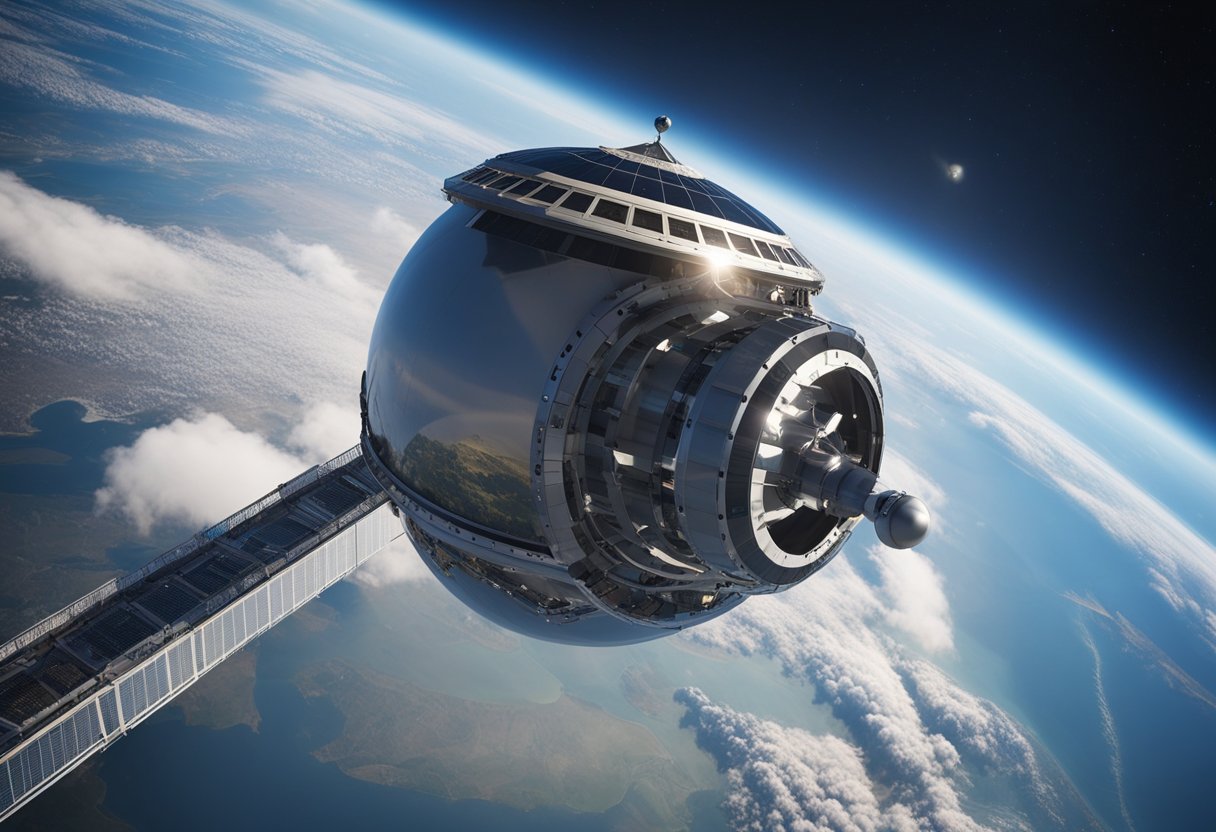
In the design of space elevators, understanding the dynamics of orbits is essential. This includes the interaction between a space elevator’s components and Earth’s gravitational field.
A synchronous orbit — specifically, a geostationary orbit — is a high-altitude orbit that allows an object to remain above the same point on Earth’s surface. This is crucial for the functionality of a space elevator as it directly affects the position of the counterweight. The required altitude for a geostationary orbit is approximately 35,786 kilometres above the Earth’s equator, where the orbital period matches the Earth’s rotation of 24 hours.
The counterweight in a space elevator design serves to provide the necessary centripetal force to keep the structure taut. It must be positioned beyond the altitude of a synchronous orbit to ensure the centre of mass provides the correct tension in the cable. Typically, this anchor would be at an altitude much higher than geostationary orbit, maintaining the system’s stability and allowing the elevator to counteract gravitational forces without drifting.
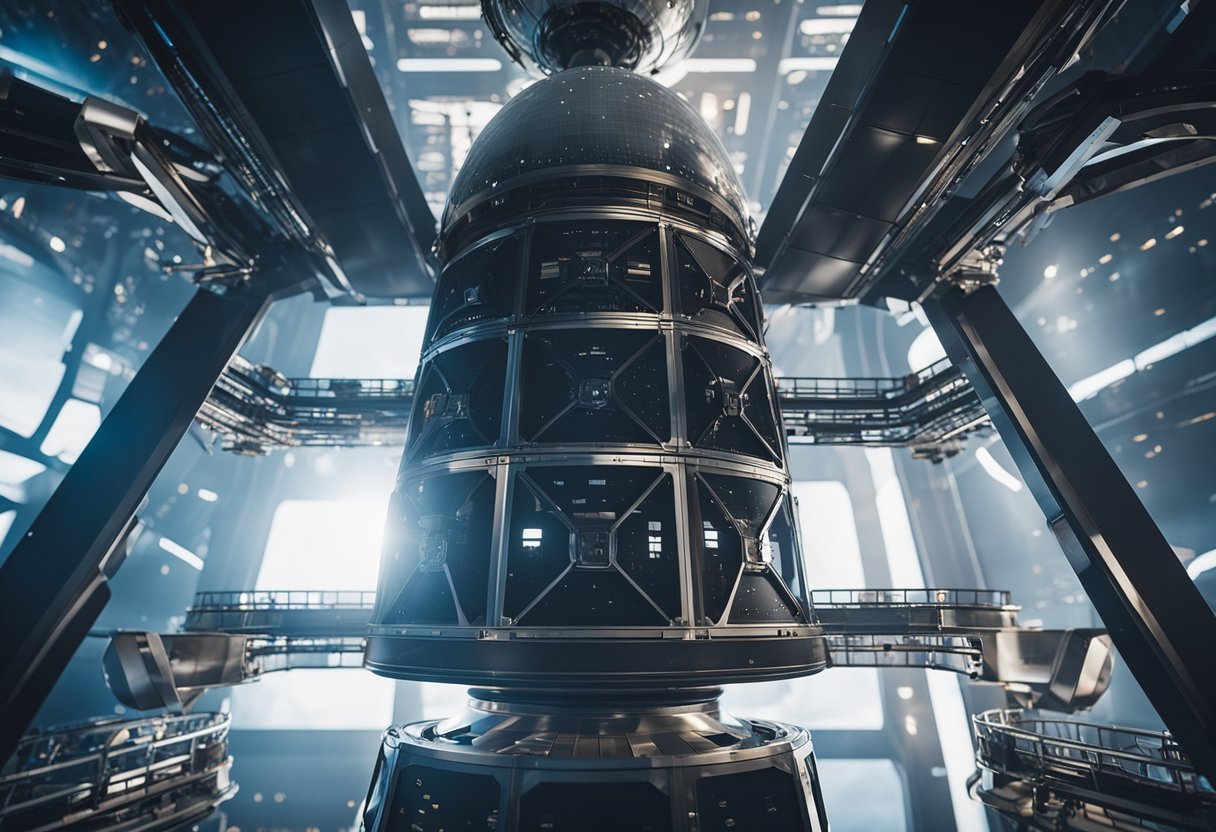
In our quest to revolutionise space travel, space elevators propose a unique approach to transporting spacecraft and payload into orbit. By using a tether anchored to Earth, we can reduce the cost per kilogram of launching materials and significantly streamline the process of integrating cargo with climbers.
Our climbers are engineered to be robust and versatile, essentially serving as vehicles travelling along the tether. These climbers possess the strength to carry various spacecraft—as well as significant payloads—into geostationary orbits. A typical climber’s design focuses on achieving optimal balance and energy efficiency to support its journey. It must manage the gravitational stresses and potential micrometeorite collisions during the ascent.
For the cargo integration process, precision is paramount. Each kilogram of payload is meticulously secured within the climber’s structure. The internal configuration of climbers is customised to accommodate diverse cargo types, from satellites to the more delicate scientific instruments earmarked for space research. Our method ensures that the payload remains intact and stable throughout the transit, mitigating any risks associated with vibrations or shifts in gravity.
Integration also extends to the potential for space tourism, as highlighted by SpaceVoyageVentures.com, which documents the promising trajectory of space tourism, including trips that may soon utilise space elevator technology. Our work here ties directly into this growing industry, bridging the gap between current spacecraft capabilities and the future of orbital journeys.

We must address the crucial challenges of collision avoidance and long-term sustainability to ensure the safety and efficacy of space elevator operations.
In designing space elevators, orbital debris avoidance is a paramount concern. Due to the high-speed travel of debris in orbit, even small particles can inflict significant damage on the elevator’s structure. Implementations of advanced tracking systems can offer real-time debris monitoring, and the adaptation of electrodynamic technologies may provide active debris removal solutions. Emphasis on robust tether materials is essential for withstanding potential impacts, as highlighted by the International Space Elevator Consortium, illuminating strategies for elevators to endure debris challenges.
For the space elevator’s enduring functionality, focusing on sustainability is indispensable. This includes both the mitigation of space debris generated by the elevator itself and the development of self-repairing materials. Techniques like “Ribbon Redundancy” allow for recovery from severe structural damage, as seen in proposals documented by the Consortium’s study reports. Our approach also involves cooperating with space-faring entities to create and abide by operational protocols that reduce the generation of new debris, thereby preserving the orbital environment for future generations and ventures, such as those documented by SpaceVoyageVentures.com.
By employing these strategies, we can aspire towards a risk-mitigated, sustainable framework for space elevator operations.
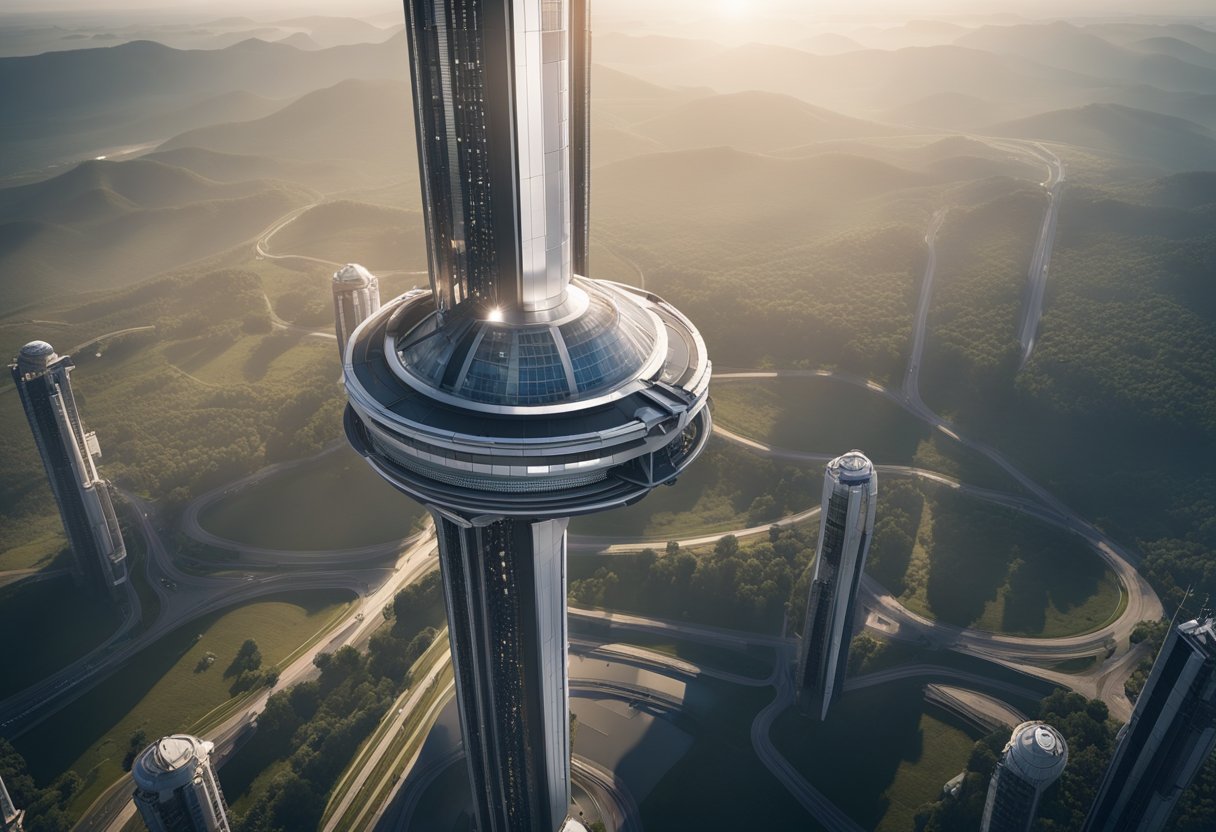
Space elevators have the capability to transform our approach to space exploration and scientific research. They promise more efficient ways to access space, offering significant benefits for these fields.
We can expect a space elevator to significantly reduce the cost and complexity of sending materials and astronauts to space. By providing a consistent transport link, a space elevator could support the establishment of bases on the Moon, aiding in our lunar exploration efforts. Moreover, as a gateway to the solar system, it could facilitate missions to other planets by serving as a launch platform for spacecraft, reducing the fuel needs for exit from Earth’s gravitational field.
The constant access a space elevator could offer us to the low Earth orbit environment would likely spur a renaissance in space-based scientific research. We could see advancements in areas like astrophysics, Earth observation, and possibly even novel experiments in zero-gravity biology and chemistry. The potential for continuous movement of equipment and samples between Earth and space would be unparalleled, impact our understanding of the universe profoundly.
In assessing the viability of a space elevator project, we must scrutinise both the economic framework and the technical and practical feasibility. Careful economic planning and rigorous feasibility studies provide the foundation for understanding the potential success of such a groundbreaking project.
The viability of a space elevator hinges on the economic feasibility which involves a thorough examination of construction costs and the long-term financial sustainability of the infrastructure. It’s essential to consider the initial financial outlay, which is substantial, alongside the economic benefits such as increased access to space. A study presented in ScienceDirect emphasises that risk reduction may have a more significant impact on investment viability than mere cost reduction, suggesting that strategic financial planning is vital.
When delving into the feasibility of constructing a space elevator, numerous studies suggest that the development of new materials, such as carbon nanotubes, has reignited the conversation about this concept becoming a reality. Smithsonians’s coverage of various proposals points to feasibility studies focusing on the technical challenges, from the production of ultra-strong materials to counteracting the forces exerted on the structure extending into space. These studies often underscore the project’s feasibility, outlining a future where such a structure could transform space travel and, by extension, space tourism as chronicled on sites like SpaceVoyageVentures.com.
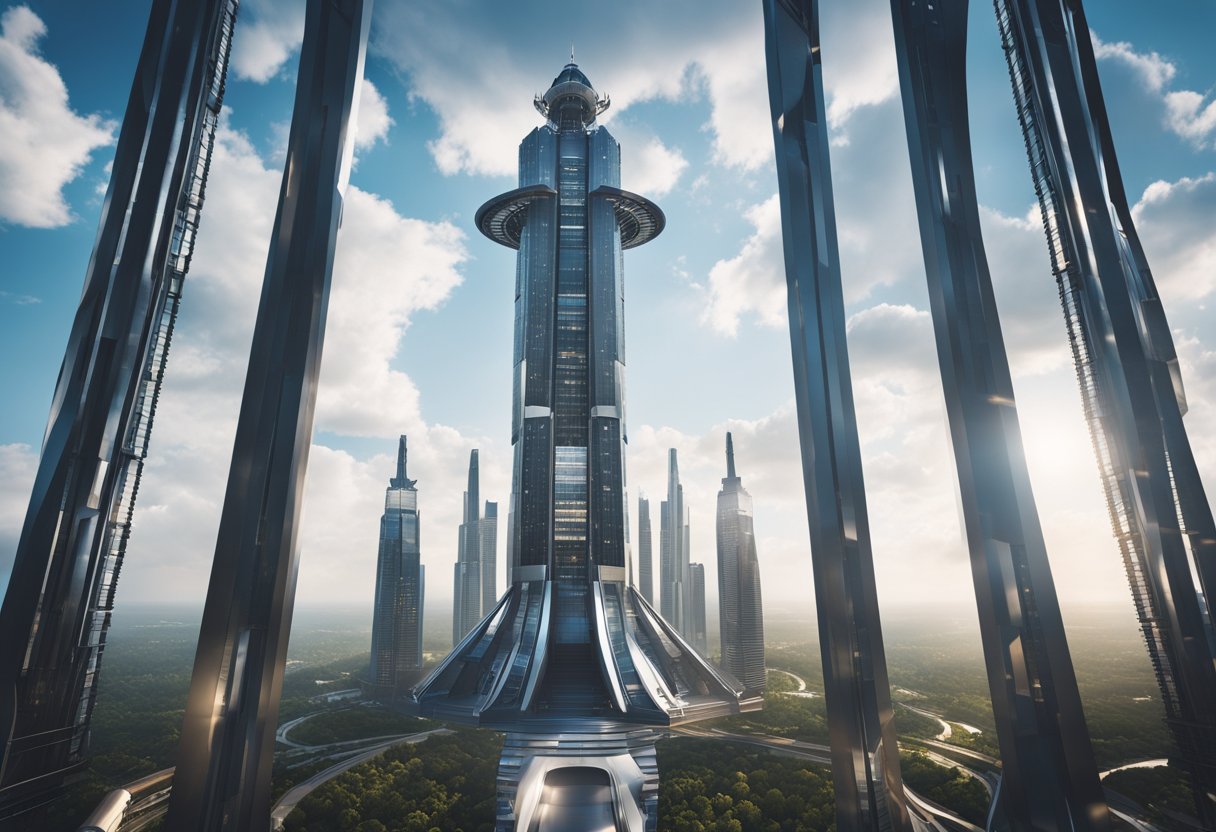
As we examine the ongoing progress in the realm of space elevators, it’s imperative to acknowledge the current research initiatives breathing new life into this concept and the pivotal role of international collaboration in turning what once was a visionary idea into a potential reality.
Significant strides have been taken in the realm of space elevator research, with entities like the International Space Elevator Consortium (ISEC) and the Japan Space Elevator Association (JSEA) at the forefront. The focus has primarily been on overcoming the technical challenges, such as developing materials robust and light enough to form the elevator’s tether, that can withstand the harsh conditions of space. The Acta Astronautica has frequently published articles detailing the technological advancements within this sphere.
A key player, LiftPort Group, has been exploring the feasibility of building a space elevator on the Moon, which, due to the lower gravity, may be a more immediately attainable goal than an Earth-based system. This initiative paves the way for valuable experience in constructing and operating a space elevator, which could inform future Earth-based projects.
Our engagement in global cooperation has never been more critical. The International Space Elevator Consortium plays a crucial role in unifying efforts by hosting annual conferences where scientists, engineers, and enthusiasts gather to exchange knowledge. NASA has also been involved, historically supporting the concept by sponsoring Space Elevator Games aimed at fostering innovation in tether materials and robot climbers.
The burgeoning field of space tourism, documented by sites like SpaceVoyageVentures.com, offers a glimpse into the commercial potential of space elevators. Our shared endeavours, across nations and disciplines, are essential to the development of infrastructure that could one day make space travel more accessible and cost-effective for all.
As we explore the potential of space elevators, we recognise their promise in revolutionising the way we access space. They offer a more sustainable and cost-effective alternative to rocket launches, potentially transforming the range and frequency of our space missions.
Space Elevator Games: In our quest to catalyse innovations that will make space elevators a tangible reality, we’ve seen remarkable progress through competitions such as the Space Elevator Games. These contests incentivise ingenious minds to tackle the technical challenges, from the development of stronger materials to the design of climbers that can ascend a tether.
Bradley Edwards: One notable figure in the space elevator community is Dr. Bradley Edwards. His pioneering work laid the foundation for current space elevator designs, including a detailed assessment of the manufacturing processes needed to create the long, sturdy cable required for such an endeavour.
Manufacturing Prospects: The manufacturing of space elevator components has become feasible with advancements in nanotechnology, specifically carbon nanotubes. We are approaching a future where producing the materials necessary for a space elevator is not only possible but also economically viable.
Lunar Space Elevator: The concept of a lunar space elevator extends our ambitions beyond Earth. The reduced gravitational force on the Moon makes the construction of an elevator there an attractive prospect, one that could significantly aid lunar exploration and development.
Upcoming Missions: We hold a steadfast belief in the power of space elevators to transform space travel in the coming decades. Our team is confident that the ongoing research and technological development will culminate in successful missions that employ space elevators, first for cargo and then for humans.
For those of us who dream of travelling beyond our world, we watch closely as projects such as the one detailed on SpaceVoyageVentures.com become more than mere flights of fancy, offering a glimpse into a near future where space tourism is part of our collective reality.
In this section, we address some of the most common enquiries regarding space elevators, from the realistic challenges in constructing one to the materials needed and the underlying principles of its operation.
Constructing a space elevator with current technology remains a significant challenge. We lack materials with the necessary tensile strength and durability to support the immense stresses involved in such a structure. Advancements in material sciences, particularly in the development of carbon nanotubes, need to mature before we can realise a fully functional space elevator.
The tether of a space elevator would require materials of extraordinary strength and lightness. Materials currently being considered include carbon nanotubes and boron nitride nanotubes due to their high tensile strength and low density, which are critical properties for the cable’s performance in the harsh conditions of space.
The estimated cost of building a space elevator is difficult to ascertain accurately due to the various unknowns in the technologies required. However, figures suggest that the initial investment could reach hundreds of billions of dollars, but with the potential to reduce the cost of transporting materials to space significantly in the long term.
The basic principle behind the operation of a space elevator involves a tether anchored to the Earth’s surface, extending to space. A counterweight in orbit keeps the tether in tension, allowing “climbers” or “elevators” to ascend and descend, transporting cargo and potentially passengers to and from space.
The primary components required for a functional space elevator include a base station, the tether or cable, climbers or elevator cars to move up and down the tether, a power delivery system to propel the climbers, and a counterweight to maintain the tether’s tension.
It is proposed that a space elevator would maintain stability through the centrifugal force generated by Earth’s rotation. This outward force would act against gravity to keep the tether taut, while the counterweight at the cable’s end ensures the overall structure remains stable.